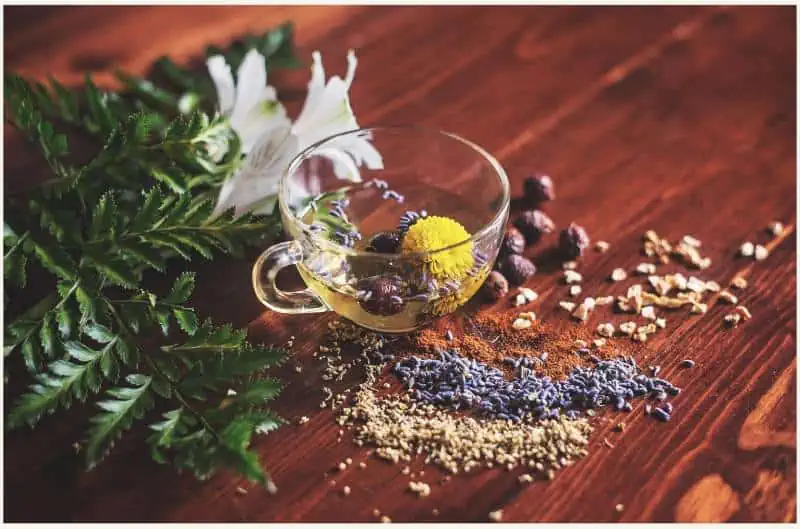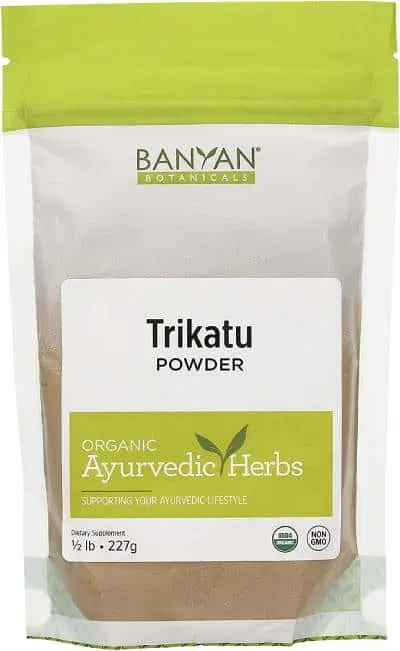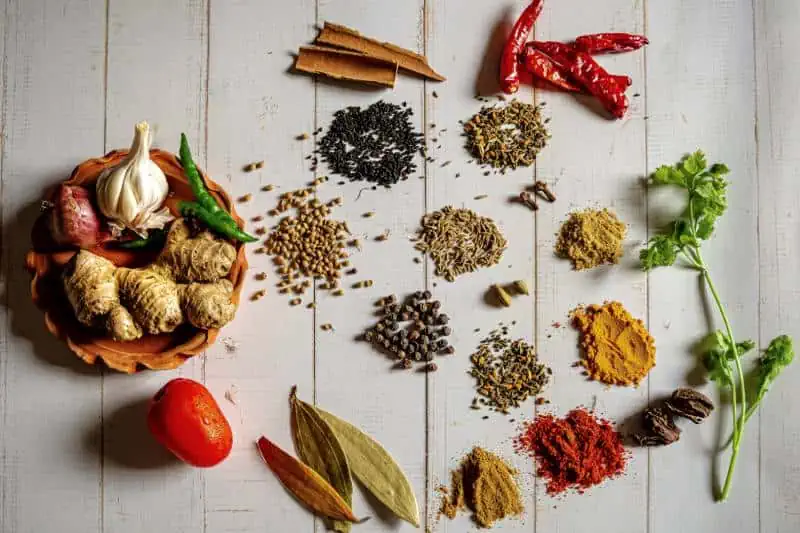Do you have thick, curly hair and soft glossy skin that is never or rarely dry? Does it take you a long time to learn things, but once you remember something, you never forget it? Are you a deep sleeper who hates getting up early?
If this sounds like you, you may be a Kapha person. Kapha is one of the three Ayurvedic doshas that determine how we look, feel, and act. So why is it important to know what dosha you are? Because doshas can become imbalanced, leading to various physical and mental ailments.
If you understand your dosha and know how to keep it in balance, you can maintain an ideal physical and mental state. So, if you think you’re a Kapha type, read on to learn everything you need to know about your dosha to live a healthy and holistic lifestyle.
Contents
- 1 What Are The Doshas?
- 2 The Role Of The Kapha Dosha
- 3 Signs Of Kapha Imbalance
- 4 How To Balance Kapha
- 4.1 Ayurvedic herbs and supplements
- 4.2 Banyan Botanicals Trikatu Powder - USDA Organic, 1/2 Pound - Heating & Stimulating - Supports...
- 4.3 Ayurvedic self-massage
- 4.4 Banyan Botanicals Kapha Massage Oil – Organic Ayurvedic Massage Oil with Chitrak and Tulsi –...
- 4.5 Kapha Balancing Diet
- 4.6 Kapha Balancing Exercises
- 4.7 Lifestyle Habits For Balancing Kapha
- 5 Final Thoughts On Balancing Kapha Dosha
What Are The Doshas?

The doshas form the foundation of Ayurvedic medicine. According to this philosophy, three energetic forces exist within us, known as the doshas. These forces influence everything in our minds and bodies, and when in balance, we experience good health and vitality. However, if our doshas are out of balance, we may suffer from physical diseases or mental distress.
The three doshas are Vata, Pitta, and Kapha. They all have different properties and energies, yet they are equally essential to our physiology. Most people have one or two dominant doshas (a dosha constitution). This constitution determines your physical and mental makeup, including your behavioral traits, recurring emotional states or thought patterns, and energy levels.
However, according to Ayurvedic beliefs, our dosha levels are constantly changing. Many things can influence this fluctuation, such as age, stage of life, and type of lifestyle. In addition, small things such as the foods we eat, the kind of exercise we do, and even the seasons can cause changes to our dosha constitution.
So what is the difference between the three doshas? Along with having different characteristics, they have a unique element combination. This is because Ayurvedic medicine is based on the idea that everything in the universe comprises the five elements; air, water, fire, ether, and earth.
The three doshas and their elements are:
- Vata dosha – Elements are air and space – Attributes are cold, light, dry, rough, flowing, and spacious.
- Pitta dosha – Elements are fire and water – Attributes are hot, light, sharp, oily, liquid, and mobile.
- Kapha dosha – Elements are water and earth – Attributes are steady, stable, heavy, slow, cold, and soft.
If you are unsure what your dominant dosha is, you can take this short online dosha determination quiz.
The Role Of The Kapha Dosha

For the rest of this article, we will focus on the Kapha dosha (pronounced “kuffa”). This energetic force is based on the elements of earth and water. It is related to spring, the time of year when we slowly emerge from hibernation.
Kapha can be loosely translated as “that which holds things together.” The Kapha dosha represents structure, grounding, and stability as the energy it carries gives substance and support to our physical body. In particular, it hydrates all the cells in our body, lubricates the joints, and maintains and protects the tissues.
Spiritually, Kapha is associated with the qualities of love, courage, stamina, dedication, and forgiveness. Some Indian cultures also see it as the energy that creates our inner strength.
Physical characteristics of a Kapha type
One way to determine your dosha type is by your physical look. Kapha types typically have a large body frame with thick, strong bones. In addition, they boast soft, smooth, glossy skin that may feel cool to the touch. Their hair may be thick, wavy, and perhaps oily, and they might have large eyes with thick eyelashes.
Note that not all Kapha types will have all these physical traits. It’s totally normal to have a Kapha constitution while only relating to a couple of these characteristics.
Typical Kapha personality
The personality, tendencies, habits, and typical emotional and mental state of Kapha people can include:
- Calm and polite nature
- Stable and grounded
- Steady appetite
- A moderate amount of sweating
- Slow to learn
- Good memory
- Prefers slow, passive, leisurely activity over fast, dynamic action
- Slow speech and a pleasant, deep voice
- Likes routine
- Sleeps deeply and prefers to wake up late than rise early
- Tendency to gain weight
Again, remember that you do not have to have all these qualities of Kapha to be a Kapha type.
Signs Of Kapha Imbalance

As mentioned earlier, sometimes one dosha may be out of balance. When this happens, the weaknesses of that dosha show up. In the case of Kapha, when in harmony, a Kapha person will be empathetic, caring, and calm with strong bones and joints, healthy skin and hair, and a healthy digestive and immune system.
However, with a Kapha dosha imbalance, a person will have excess moisture in their body and may have a combination of the following symptoms:
- Sluggishness, laziness, lacking energy
- Lack of motivation and enthusiasm for anything
- Feeling tired all the time and over-sleeping
- Feeling withdrawn and isolated
- Food cravings and emotional overeating
- Slow digestion or sluggish bowel movements
- Prone to weight gain
- Very oily skin or hair
- Large pores of acne
- Mucus buildup
- Breathing issues such as asthma, allergies
- Depression
How To Balance Kapha
If you resonate with some of the imbalance symptoms listed above, don’t fret. The good news is that there are many things you can do to reduce or increase Kapha. For example, you can make changes to your diet, exercise, and lifestyle to bring your body and mind back into harmony. So let’s explore further how to treat or prevent Kapha imbalance.
Ayurvedic herbs and supplements

Banyan Botanicals Trikatu Powder - USDA Organic, 1/2 Pound - Heating & Stimulating - Supports...
See latest priceCertain Ayurvedic herbal supplements can help to balance the Kapha Dosha. However, a one-shot herbal remedy for all sorts of Kapha-related issues is Trikatu. Trikatu combines three spices; ginger, Pippali, and black pepper, which are all super beneficial for the Kapha body type.
Trikatu is heating and stimulating and supports the digestion of heavy food. Thus, it can eliminate digestive issues, assist with weight management, and boost energy levels.
The Banyan Botanicals Trikatu Powder is easy to use as you can add it to your food while cooking, such as in soups, curries, and stews.
Alternatively, you can take it as a supplement. I recommend the certified Organic India Trikatu Herbal Supplement.
Ayurvedic self-massage

Banyan Botanicals Kapha Massage Oil – Organic Ayurvedic Massage Oil with Chitrak and Tulsi –...
See latest priceIf you’ve ever given yourself a foot massage, you’ll know just how good it feels. Self-massage is an essential daily practice for Ayurveda practitioners, known as daily abhyanga. This short Youtube video demonstrates Ayurvedic self-massage techniques for your face, head, and entire body.
Always use warm oil for an Ayurvedic self-massage. Sesame oil is a great choice, but I love the Banyan Botanicals Kapha Massage Oil. It combines organic sesame and sunflower oils, which warms the body and invigorates the mind.
Kapha Balancing Diet

For each dosha, there are optimum foods you should consume along with eating habits you should follow. For example, according to Ayurveda, Kapha types should consume light, dry, and warm foods that have pungent, bitter, or astringent tastes.
A Kapha diet should consist of whole, freshly cooked foods rather than raw, cold food. What’s more, sugar can aggravate Kapha in the body, so you should avoid sugary foods and use honey (in moderation) as a sweetener instead.
It is advisable to eat regular, routine meals. Ayurvedic guidance for the Kapha body also suggests eating light meals in the morning and the evening and a more substantial lunch.
The following foods are all good for a Kapha diet:
- Lighter fruits like apples and pears
- All spices except salt – Heating spices like chili, cayenne pepper, ginger, cinnamon, and cumin are ideal.
- Pumpkin seeds and sunflower seeds
- Low-fat milk – consuming it in warm drinks like chai tea is best
- Most beans
- Most vegetables
- Grains like barley and millet
Here are some foods that Kapha types should avoid:
- Heavy or sour fruits like oranges, bananas, dates, figs, pineapples, coconuts, and avocados.
- Zucchini, cucumbers, sweet potatoes
- Nuts
- Any highly processed or fried foods like fast food or ready meals
- Heavy, salty, and oily foods, including cheese, fries, and cakes
- Cold, iced, or fizzy drinks
To learn more about eating to the Kapha body type, read Ayurveda Cooking for Beginners by Laura Plumb. This Ayurvedic cookbook features cooking tips, guidance, meal plans, and ayurvedic recipes for pacifying Kapha.
Kapha Balancing Exercises

If you have an imbalance of Kapha, you may feel tired, sluggish, and not want to get up and move. The best way to break out of this feeling is to do the opposite of what your mind tells you; do some intense, vigorous movement.
Yes, you may not feel like going for a run or doing cross fit, but it will get your blood and lymph moving, increasing your energy and boosting your mood. Regular exercise also stimulates digestion and metabolism, helping to relieve digestive issues like constipation.
Exercises that are great for the Kapha body type include:
- Running/jogging
- Hiking/mountain climbing
- Dancing
- Zumba
- Cross-fit
- Boxing
- Martial Arts
- Vinyasa or Ashtanga yoga
- Aerobics
Aim to do these exercises at least five times a week to keep your Kapha dosha in balance.
Lifestyle Habits For Balancing Kapha

In addition to diet and exercise, there are several things you can do in your daily life to keep Kapha balanced.
One of the most important things for the Kapha dosha is to keep your body warm and dry. Being in cold, wet environments like outside in the rain is terrible for Kapha body types.
As a Kapha dosha imbalance is due to excess moisture, you should always try to stay warm and dry. This means wearing an extra layer to maintain a warm body temperature and keeping an umbrella in your bag in case of unexpected downpours. In the winter, take regular sauna sessions, eat warm meals and take warm drinks like tea with you when you go out.
Some other things you can introduce into your lifestyle are:
- Regularly stimulating your senses with upbeat music and exotic smells.
- Trying new things and taking risks.
- Breaking routine sometimes and acting spontaneously.
- Waking up at sunrise (or before).
- Restraining from taking naps during the day or sleeping in until late.
Final Thoughts On Balancing Kapha Dosha
When in balance, the Kapha dosha gives us feelings of stability and calmness, improves our memory, and keeps our cells healthy. However, excess Kapha can do more harm than good, playing havoc with our energy, mood, and digestion.
Luckily, the holistic science of Ayurveda has many ancient tools and techniques personalized to each dosha. Therefore, knowing our dosha type empowers us to make diet and lifestyle choices that enhance our health and well-being.


